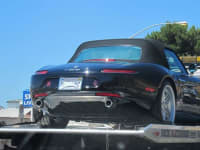Electric car owners sometimes need to make a longer distance trip than the electric range will allow. Camping trips are often taken taken across country. Long distance truckers travel hundreds of miles.
People just want to take trips without getting tired at their destination.
I propose new electric rail vehicles where the operator drives their vehicle onto an individual rail ferry car and then remains parked for the ride. Electric cars can plug in and charge during the trip.
Fatigue: When people travel long distances, fatigue is a factor. Being able to rest or nap during a trip would keep the driver – and occupants – fresher and able to enjoy more of their time at their destination.
Efficiency: Rail travel is far more efficient than highway travel. CSX advertises that in rail travel, one ton of freight can be transported 450 miles on a gallon of fuel. Compare that 10 mpg for truck and RV trailer (5 ton), or 5 mpg for a tractor trailer (10 ton). Today’s fuel costs are very high. On a 300 mile trip, a pickup towing a camper gets 10 mpg, using 30 gallons of gasoline (about $120) and take about 5 hours. I would pay that amount to just sit in my truck and relax for those 5 hours.
Vehicle life: Transferring wear and tear to a rail car would extend vehicle life.
Scenic travel: Rail travel is often routed through very scenic routes. It is more relaxing to stay in the vehicle just sightseeing than concentrating on the road ahead. In addition, travel could occur overnight (sleeping in a vehicle?).
Road Congestion: Removing traffic from the main roads would decrease road traffic, especially if tractor trailers use this system.
Existing Rail travel is not feasible: Rail travel only stops at occasional train stations, and additional transport is required once you arrive. Plus if you have cargo, whether it is vacation materials or cargo, it would have to be loaded and unloaded at the depot.
Existing Rail travel with your car is not feasible: There are already “auto-trains,” but these are very expensive, run infrequently, and on very few routes, and require passenger fare in addition to car fare.
How to make it work:
The driver of the vehicle would download an app controlling the route, ordering a ferry vehicle and extracting payment. The ferry vehicle would be waiting for the driver when they arrive at the initial depot. At the destination, the driven vehicle would disembark, and continue the journey. The individual rail car would have its own electric engine and batteries. Rest stops would be placed strategically (maybe shared with highway rest stops), but the drive vehicle would not be removed from the individual rail car.
Rail infrastructure would have to be improved. Rail travel is used fairly infrequently, but many runs are parallel to major highways. This activity can be slowly implemented run by run, highway by highway. This would be a fun way of seeing the country!
Like this entry?
-
About the Entrant
- Name:Al Klesczewski
- Type of entry:individual
- Software used for this entry:none
- Patent status:none





